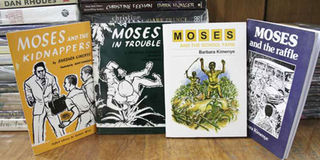Vital tips from the Moses series on how to spellbind your readers

Kenyan writers should consider writing books in a series. The advantage of a series is that it’s not only easy to market but also keeps readers wanting to read the next book. When a boy or girl reads one book in the Moses series, they will want to have read the other 10 books. PHOTO | FILE
What you need to know:
- The first one is that the writer must understand what can spellbind their audience. Beautiful written, the series captures the yearnings and frustrations of preteen and teenage boys.
- Also, she uses simple language; even the humour is simple and children can identify with it. Moses wants to become internationally famous so he wants to escape to America. He hopes to become the first African in space because “heights never worried him as he was climbing trees before he was five years old”! What a reason to become an astronaut!
“I cannot say there was anything unusually impressive about the institute itself. To me it looked the poorer, seedier type of junior secondary school, and I was certainly in a position to make the comparison. There was a collection of low, shabby buildings, most of them with thatched roofs, and a compound that no self-respecting cowherd would allow his beasts to graze in”.
These are the words of the character Moses Kibaya in Barbara Kimenye’s first title, Moses, in the Moses series. I was awestruck by the darting arrogance of Moses—warm, alert, caustic, even dangerous. It was a mesmerising portrait of a boy’s world; a world beaming with laughter feints and counterfeits, mischief and merrymaking.
I cannot remember who lent me my first title of the series. When I first read the book by happenstance, it was like greeting a stranger by mistake and then striking an immediate friendship. Years later, I went into a bookshop in Nairobi, to buy the first title for my daughter. I remembered looking at the neatly arranged books and foolishly wondered whether they knew me.
Something came and went between us, a meaningless familiarity. Did they know they had thrilled and hounded me as a young boy? The books were like old friends I had not seen for a long time. They held the promise of transporting my daughter to an illuminated paradise of adventure. I had read them under the fading light of a flickering lamb, she would be reading them under the blinding lights of Nairobi but I hoped she would enjoy the voyage as I did.
The Moses series is a classic not only in Kenya but also in Eastern Africa; having sold more than one million copies. There are several lessons Kenyan writers can learn from Barbara Kimenye. The first one is that the writer must understand what can spellbind their audience. Beautiful written, the series captures the yearnings and frustrations of preteen and teenage boys.
SIMPLE LANGUAGE
Venturing into the amorphous terrain of boys in boarding school, the author shines the light like one threatening to expose the hidden things of boys’ shame. Ms Kimenye seems to have understood that, at that age, one of the major longings for boys is for heroes; people who will do daring exploits.
In the first title in the series, Moses, the main character, Moses Kibaya, joins his seventh school, Mukibi Educational Institute of Sons of African Gentlemen, after being expelled from six others. He is painted as a rugged ruffian, which somehow transfixes young boys. When boys in boarding school read about Moses Kibaya, they get envious. His overly casual manner and endless adventure is irresistible.
Also, she uses simple language; even the humour is simple and children can identify with it. Moses wants to become internationally famous so he wants to escape to America. He hopes to become the first African in space because “heights never worried him as he was climbing trees before he was five years old”! What a reason to become an astronaut!
One of my major struggles with writers has been to get writers to grade their language so it fits the level of their audience. Ms Kimenye cracks it; not only the language for the humour but also satire. Ms Kimenye’s satire is as forbidding as the mean Mr Mukibi.
When describing the classroom, Moses Kibaya says, it was “a good copy of an old cowshed, after the cows have finished living in it. The walls were made of unplastered mud and wattle. On two sides they only rose to about four feet high, leaving open spaces up to the sagging thatched roof.” This is in easy language that paints a clear picture.
The final lesson is that Ms Kimenye is able to weave a series adventure narrative not only of one story but 11 stories (making the 11 books in the Moses series) all into one grand story with three major running characters: Moses Kibaya (Holy Moses), King Kong and Rukia.
Kenyan writers should consider writing books in a series. The advantage of a series is that it’s not only easy to market but also keeps readers wanting to read the next book. When a boy or girl reads one book in the Moses series, they will want to have read the other 10 books.
No wonder the series has sold more than one million copies! That’s a good reason to pay keen interest to Ms Kimenye’s Moses series.





